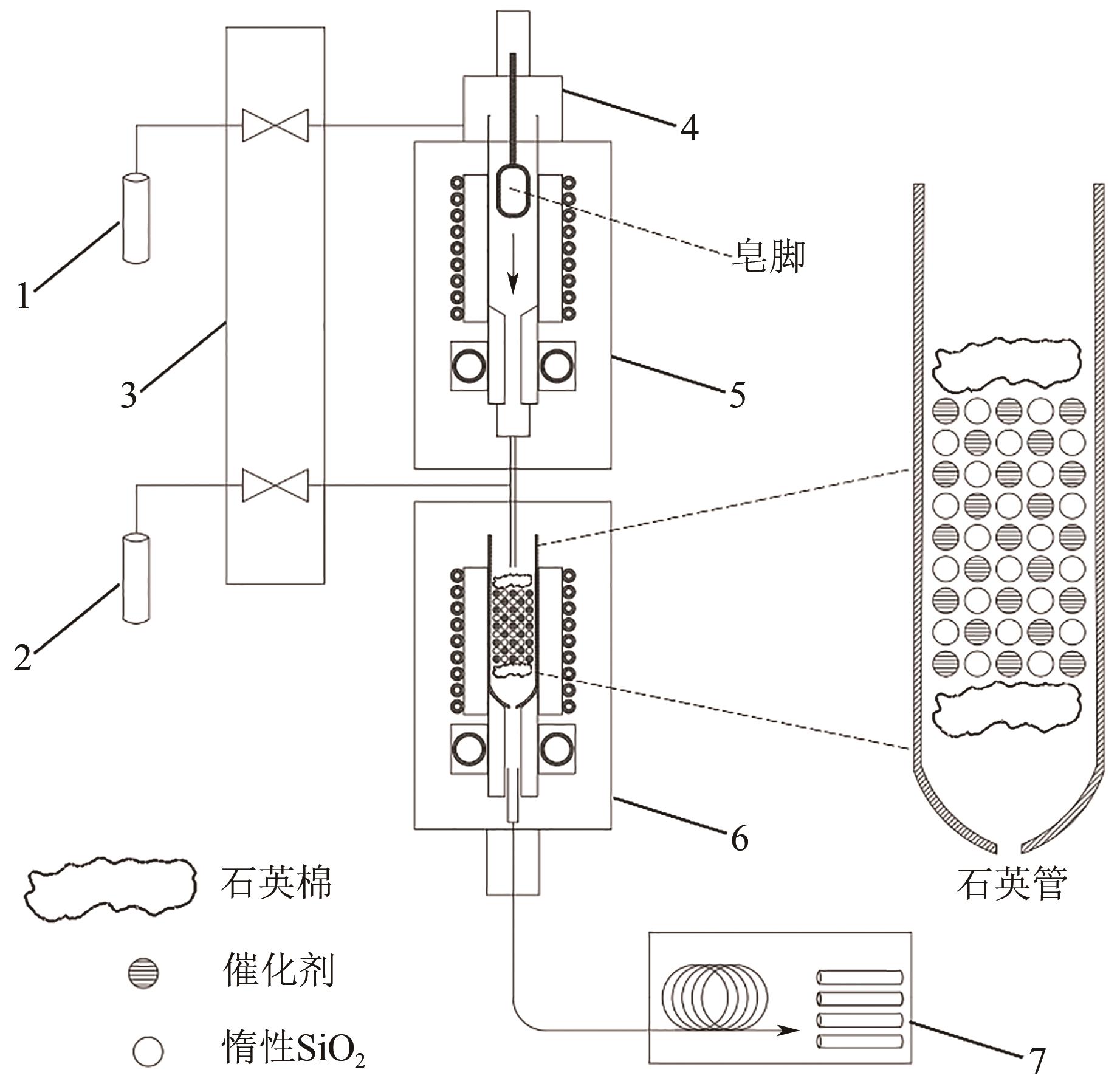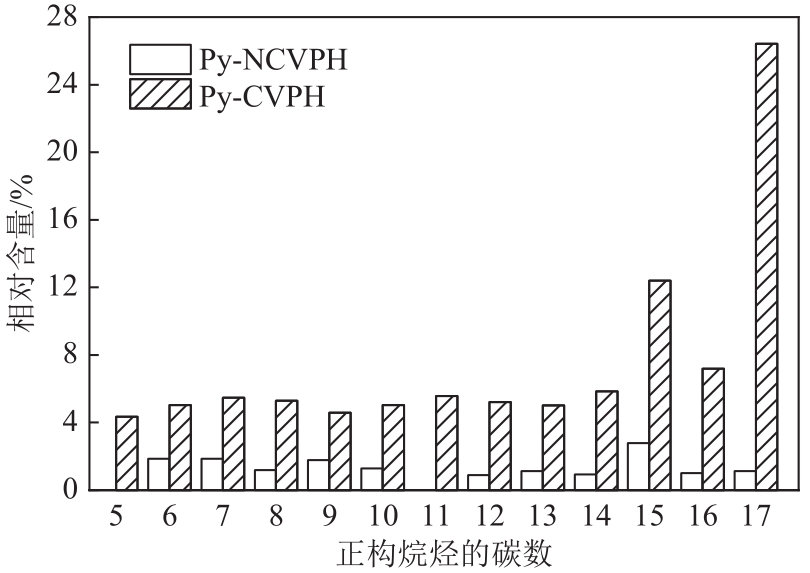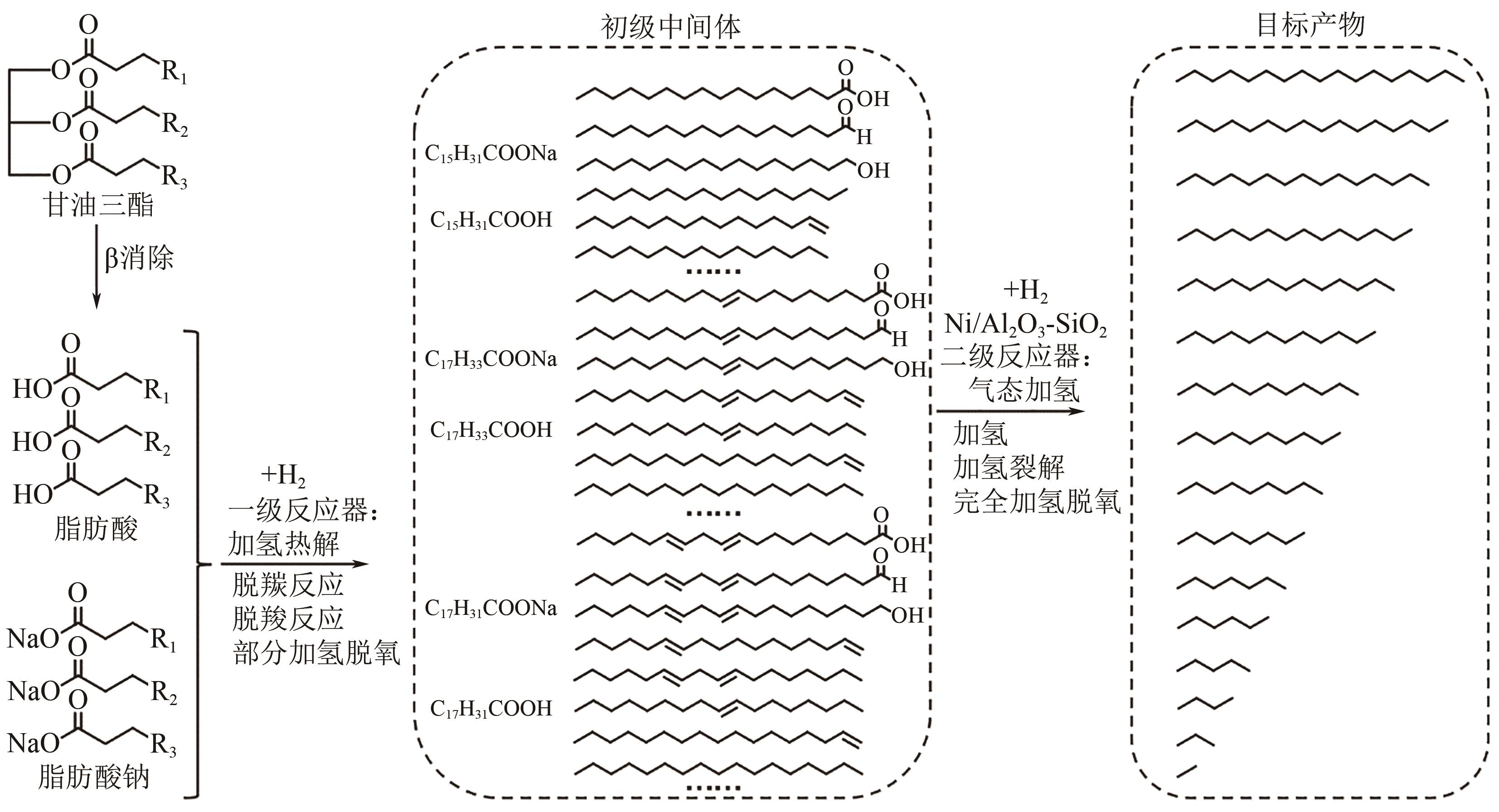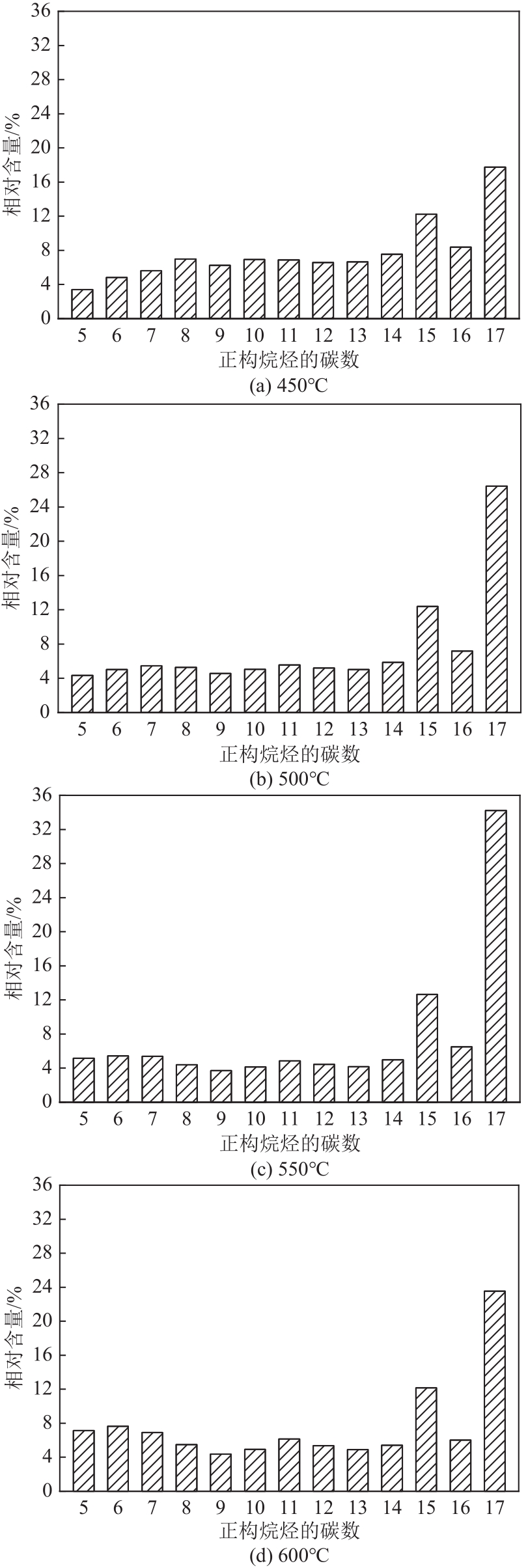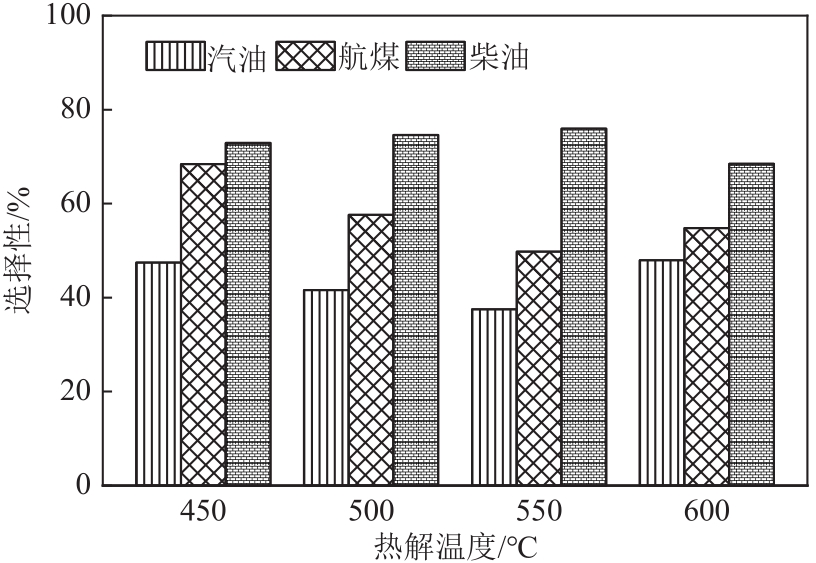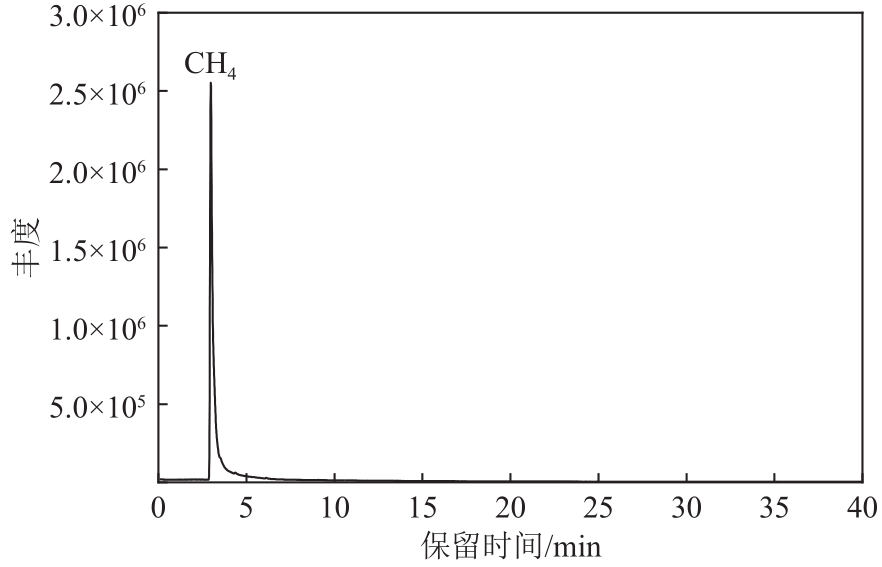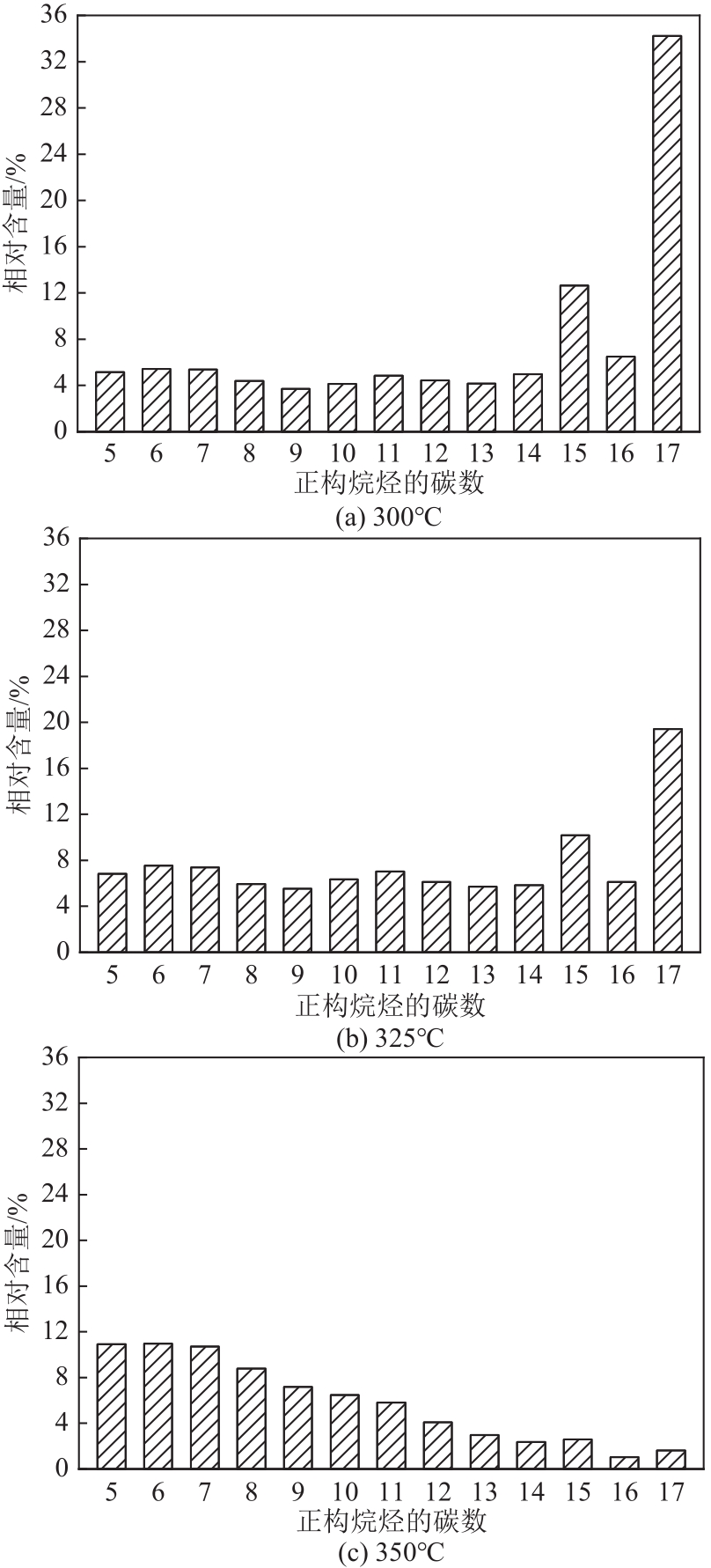化工进展 ›› 2023, Vol. 42 ›› Issue (6): 2874-2883.DOI: 10.16085/j.issn.1000-6613.2022-1500
皂脚热解-催化气态加氢制备生物燃料
- 1.南京林业大学化学工程学院,江苏 南京 210037
2.中国林业科学研究院林产化学工业研究所,江苏 南京 210042
-
收稿日期:2022-08-15修回日期:2022-10-14出版日期:2023-06-25发布日期:2023-06-29 -
通讯作者:王佳 -
作者简介:李栋先(1996—),男,硕士研究生,研究方向为有机固废热化学转化。E-mail:ldx@njfu.edu.cn。 -
基金资助:国家自然科学基金(52006106);国家重点研发计划(2019YFB1504001)
Producing biofuels from soapstock via pyrolysis and subsequent catalytic vapor-phase hydrotreating process
LI Dongxian1( ), WANG Jia1,2(
), WANG Jia1,2( ), JIANG Jianchun1,2
), JIANG Jianchun1,2
- 1.College of Chemical Engineering, Nanjing Forestry University, Nanjing 210037, Jiangsu, China
2.Institute of Chemical Industry of Forest Products, Chinese Academy of Forestry, Nanjing 210042, Jiangsu, China
-
Received:2022-08-15Revised:2022-10-14Online:2023-06-25Published:2023-06-29 -
Contact:WANG Jia
摘要:
皂脚的资源化、高值化利用对减少环境污染和实现碳中和具有重要的意义。本文以皂脚为原料,采用双级加压固定床为反应器,对其进行热解-催化气态加氢处理以制备生物燃料。研究了皂脚热解-非催化和催化气态加氢处理对产物正构烷烃的影响,并提出了皂脚热解-催化气态加氢制备正构烷烃的反应机理。以最大化生成正构烷烃为目标,又对热解温度和气态加氢温度工艺参数进行了优化处理。实验结果表明,与非催化条件相比,在Ni/Al2O3-SiO2催化剂的作用下,热解初级中间体被完全脱氧和氢化,使得C5~C17正构烷烃的相对含量由15.8%增加至97.3%。随着热解温度的升高,正构烷烃的产量先升高再降低,550℃时产量最高;随着气态加氢温度的升高,正构烷烃的产量逐渐降低,300℃时产量最高。
中图分类号:
引用本文
李栋先, 王佳, 蒋剑春. 皂脚热解-催化气态加氢制备生物燃料[J]. 化工进展, 2023, 42(6): 2874-2883.
LI Dongxian, WANG Jia, JIANG Jianchun. Producing biofuels from soapstock via pyrolysis and subsequent catalytic vapor-phase hydrotreating process[J]. Chemical Industry and Engineering Progress, 2023, 42(6): 2874-2883.
| 元素质量分数/% | 脂肪酸组成/% | ||||||||
|---|---|---|---|---|---|---|---|---|---|
| C | H | O① | N | 棕榈酸 | 油酸 | 亚油酸 | 亚麻酸 | 硬脂酸 | 其他 |
| 71.2 | 11.7 | 16.9 | 0.2 | 10.1 | 31.7 | 32.4 | 11.4 | 5.7 | 8.7 |
表1 牡丹籽油皂脚的元素分析和脂肪酸组成
| 元素质量分数/% | 脂肪酸组成/% | ||||||||
|---|---|---|---|---|---|---|---|---|---|
| C | H | O① | N | 棕榈酸 | 油酸 | 亚油酸 | 亚麻酸 | 硬脂酸 | 其他 |
| 71.2 | 11.7 | 16.9 | 0.2 | 10.1 | 31.7 | 32.4 | 11.4 | 5.7 | 8.7 |
| 1 | 罗兰, 陈红莉, 唐辉, 等. 棉油皂脚酸化油脂肪酸的分子蒸馏法优化分离及其组分检测[J]. 中国饲料, 2018(4): 70-74. |
| LUO Lan, CHEN Hongli, TANG Hui, et al.Optimization of molecular distillation separation of fatty acids in cotton soap and its component detection[J]. China Feed, 2018(4): 70-74. | |
| 2 | WANG Yunpu, WU Qiuhao, DUAN Dengle, et al. Ex-situ catalytic upgrading of vapors from fast microwave-assisted co-pyrolysis of Chromolaena odorata and soybean soapstock[J]. Bioresource Technology, 2018, 261: 306-312. |
| 3 | 邵彦智, 方哲, 汪廷, 等. 油脂中皂脚总脂肪物含量测定方法的研究与应用[J]. 现代食品, 2021(12): 74-75, 80. |
| SHAO Yanzhi, FANG Zhe, WANG Ting, et al. Research and application of the method for measuring the total fat content of soapstock in oil[J]. Modern Food, 2021(12): 74-75, 80. | |
| 4 | 王允圃. 粮油工业皂脚微波驱动催化热解制备富烃生物油的研究[D]. 南昌: 南昌大学, 2020. |
| WANG Yunpu. Production of hydrocarbon-rich bio-oil using microwave-driven catalytic pyrolysis of vegetable oil soapstock[D]. Nanchang: Nanchang University, 2020. | |
| 5 | LOPES P R M, MONTAGNOLLI R N, CRUZ J M, et al. Production of rhamnolipids from soybean soapstock: Characterization and comparation with synthetics surfactants[J]. Waste and Biomass Valorization, 2021, 12(4): 2013-2023. |
| 6 | BORSATTI L, VIEIRA S L, STEFANELLO C, et al. Apparent metabolizable energy of by-products from the soybean oil industry for broilers: Acidulated soapstock, glycerin, lecithin, and their mixture[J]. Poultry Science, 2018, 97(1): 124-130. |
| 7 | 罗兰, 陈红莉, 唐辉, 等. 棉油皂脚饲料化的可行性研究[J]. 饲料工业, 2017, 38(7): 31-34. |
| LUO Lan, CHEN Hongli, TANG Hui, et al. A study on the feasibility of cottonseed soapstock made into feed[J]. Feed Industry, 2017, 38(7): 31-34. | |
| 8 | DUAN Dengle, RUAN Roger, LEI Hanwu, et al. Microwave-assisted co-pyrolysis of pretreated lignin and soapstock for upgrading liquid oil: Effect of pretreatment parameters on pyrolysis behavior[J]. Bioresource Technology, 2018, 258: 98-104. |
| 9 | NANDA S, RANA R, HUNTER H N, et al. Hydrothermal catalytic processing of waste cooking oil for hydrogen-rich syngas production[J]. Chemical Engineering Science, 2019, 195: 935-945. |
| 10 | BHATIA S K, GURAV R, CHOI T R, et al. Conversion of waste cooking oil into biodiesel using heterogenous catalyst derived from cork biochar[J]. Bioresource Technology, 2020, 302: 122872. |
| 11 | LI Peng, SAKURAGI Kiyoshi, MAKINO Hisao. Extraction techniques in sustainable biofuel production: A concise review[J]. Fuel Processing Technology, 2019, 193: 295-303. |
| 12 | WANG Jia, ZHONG Zhaoping, DING Kuan, et al. Successive desilication and dealumination of HZSM-5 in catalytic conversion of waste cooking oil to produce aromatics[J]. Energy Conversion and Management, 2017, 147: 100-107. |
| 13 | GEIGER Philippe, Jürg BUCHLI, Ramona RÜEGG, et al. Evaluation of the effect of a novel membrane filtration system on the lifespan of frying oil[J]. International Journal of Food Science & Technology, 2021, 56(4): 1844-1854. |
| 14 | SU G, ONG H C, MOFIJUR M, et al. Pyrolysis of waste oils for the production of biofuels: A critical review[J]. Journal of Hazardous Materials, 2022, 424: 127396. |
| 15 | WANG Jia, JIANG Jianchun, SUN Yunjuan, et al. Catalytic degradation of waste rubbers and plastics over zeolites to produce aromatic hydrocarbons[J]. Journal of Cleaner Production, 2021, 309: 127469. |
| 16 | QIU Bingbing, YANG Chenhao, SHAO Qianni, et al. Recent advances on industrial solid waste catalysts for improving the quality of bio-oil from biomass catalytic cracking: A review[J]. Fuel, 2022, 315: 123218. |
| 17 | LAPPI Hanna, Raimo ALÉN. Production of vegetable oil-based biofuels—Thermochemical behavior of fatty acid sodium salts during pyrolysis[J]. Journal of Analytical and Applied Pyrolysis, 2009, 86(2): 274-280. |
| 18 | WANG Yunpu, KE Linyao, PENG Yujie, et al. Characteristics of the catalytic fast pyrolysis of vegetable oil soapstock for hydrocarbon-rich fuel[J]. Energy Conversion and Management, 2020, 213: 112860. |
| 19 | WU Qiuhao, JIANG Lin, WANG Yunpu, et al. Pyrolysis of soybean soapstock for hydrocarbon bio-oil over a microwave-responsive catalyst in a series microwave system[J]. Bioresource Technology, 2021, 341: 125800. |
| 20 | DAI Leilei, FAN Liangliang, LIU Yuhuan, et al. Production of bio-oil and biochar from soapstock via microwave-assisted co-catalytic fast pyrolysis[J]. Bioresource Technology, 2017, 225: 1-8. |
| 21 | ONG H C, CHEN W H, FAROOQ A, et al. Catalytic thermochemical conversion of biomass for biofuel production: A comprehensive review[J]. Renewable and Sustainable Energy Reviews, 2019, 113: 109266. |
| 22 | JIANG Lin, WANG Yunpu, DAI Leilei, et al. Integrating pyrolysis and ex-situ catalytic reforming by microwave heating to produce hydrocarbon-rich bio-oil from soybean soapstock[J]. Bioresource Technology, 2020, 302: 122843. |
| 23 | DAI Leilei, FAN Liangliang, DUAN Dengle, et al. Production of hydrocarbon-rich bio-oil from soapstock via fast microwave-assisted catalytic pyrolysis[J]. Journal of Analytical and Applied Pyrolysis, 2017, 125: 356-362. |
| 24 | DUAN Dengle, ZHANG Yayun, WANG Yunpu, et al. Production of renewable jet fuel and gasoline range hydrocarbons from catalytic pyrolysis of soapstock over corn cob-derived activated carbons[J]. Energy, 2020, 209: 118454. |
| 25 | YANG Xiuhua, PENG Yujie, WANG Yunpu, et al. Conversion of soybean soapstock into hydrocarbon fuel by microwave-assisted catalytic fast pyrolysis using MCM-41/HZSM-5 in a downdraft reactor[J]. Chemical Engineering and Processing-Process Intensification, 2020, 156: 108109. |
| 26 | ESCHENBACHER A, SARAEIAN A, JENSEN P A, et al. Deoxygenation of wheat straw fast pyrolysis vapors over Na-Al2O3 catalyst for production of bio-oil with low acidity[J]. Chemical Engineering Journal, 2020, 394: 124878. |
| 27 | STUMMANN M Z, HØJ M, GABRIELSEN J, et al. A perspective on catalytic hydropyrolysis of biomass[J]. Renewable and Sustainable Energy Reviews, 2021, 143: 110960. |
| 28 | RESENDE F L P. Recent advances on fast hydropyrolysis of biomass[J]. Catalysis Today, 2016, 269: 148-155. |
| 29 | CHANDLER D S, RESENDE F L P. Comparison between catalytic fast pyrolysis and catalytic fast hydropyrolysis for the production of liquid fuels in a fluidized bed reactor[J]. Energy & Fuels, 2019, 33(4): 3199-3209. |
| 30 | LI Zhaoying, ZHONG Zhaoping, YANG Qirong, et al. Parametric study of catalytic hydropyrolysis of rice husk over a hierarchical micro-mesoporous composite catalyst for production of light alkanes, alkenes, and liquid aromatic hydrocarbons[J]. Fuel, 2022, 310: 122457. |
| 31 | JAN O, MARCHAND R, ANJOS L C A, et al. Hydropyrolysis of lignin using Pd/HZSM-5[J]. Energy & Fuels, 2015, 29(3): 1793-1800. |
| 32 | WANG Jia, ZHANG Bo, ZHONG Zhaoping, et al. Catalytic fast co-pyrolysis of bamboo residual and waste lubricating oil over an ex-situ dual catalytic beds of MgO and HZSM-5: Analytical PY-GC/MS study[J]. Energy Conversion and Management, 2017, 139: 222-231. |
| 33 | ADEBANJO A O, DALAI A K, BAKHSHI N N. Production of diesel-like fuel and other value-added chemicals from pyrolysis of animal fat[J]. Energy & Fuels, 2005, 19(4): 1735-1741. |
| 34 | 韩璐, 郑煜, 周云帆, 等. 汽油胶质的形成机理及影响因素研究进展[J]. 石油化工, 2021, 50(3): 289-293. |
| HAN Lu, ZHENG Yu, ZHOU Yunfan, et al. Research progress on formation mechanism and influencing factors of gasoline gum[J]. Petrochemical Technology, 2021, 50(3): 289-293. | |
| 35 | GOSSELINK R W, HOLLAK S A W, CHANG S W, et al. Reaction pathways for the deoxygenation of vegetable oils and related model compounds[J]. ChemSusChem, 2013, 6(9): 1576-1594. |
| 36 | WANG Jia, ZHONG Zhaoping, DING Kuan, et al. Catalytic fast pyrolysis of bamboo sawdust via a two-step bench scale bubbling fluidized bed/fixed bed reactor: Study on synergistic effect of alkali metal oxides and HZSM-5[J]. Energy Conversion and Management, 2018, 176: 287-298. |
| 37 | WANG Jia, JIANG Jianchun, LI Dongxian, et al. Creating values from wastes: Producing biofuels from waste cooking oil via a tandem vapor-phase hydrotreating process[J]. Applied Energy, 2022, 323: 119629. |
| [1] | 时永兴, 林刚, 孙晓航, 蒋韦庚, 乔大伟, 颜彬航. 二氧化碳加氢制甲醇过程中铜基催化剂活性位点研究进展[J]. 化工进展, 2023, 42(S1): 287-298. |
| [2] | 程涛, 崔瑞利, 宋俊男, 张天琪, 张耘赫, 梁世杰, 朴实. 渣油加氢装置杂质沉积规律与压降升高机理分析[J]. 化工进展, 2023, 42(9): 4616-4627. |
| [3] | 邵志国, 任雯, 许世佩, 聂凡, 许毓, 刘龙杰, 谢水祥, 李兴春, 王庆吉, 谢加才. 终温对油基钻屑热解产物分布和特性影响[J]. 化工进展, 2023, 42(9): 4929-4938. |
| [4] | 李志远, 黄亚继, 赵佳琪, 于梦竹, 朱志成, 程好强, 时浩, 王圣. 污泥与聚氯乙烯共热解重金属特性[J]. 化工进展, 2023, 42(9): 4947-4956. |
| [5] | 毛善俊, 王哲, 王勇. 基团辨识加氢:从概念到应用[J]. 化工进展, 2023, 42(8): 3917-3922. |
| [6] | 王兰江, 梁瑜, 汤琼, 唐明兴, 李学宽, 刘雷, 董晋湘. 快速热解铂前体合成高分散的Pt/HY催化剂及其萘深度加氢性能[J]. 化工进展, 2023, 42(8): 4159-4166. |
| [7] | 王晓晗, 周亚松, 于志庆, 魏强, 孙劲晓, 姜鹏. 不同晶粒尺寸Y分子筛的合成及其加氢裂化反应性能[J]. 化工进展, 2023, 42(8): 4283-4295. |
| [8] | 李海东, 杨远坤, 郭姝姝, 汪本金, 岳婷婷, 傅开彬, 王哲, 何守琴, 姚俊, 谌书. 炭化与焙烧温度对植物基铁碳微电解材料去除As(Ⅲ)性能的影响[J]. 化工进展, 2023, 42(7): 3652-3663. |
| [9] | 姚丽铭, 王亚琢, 范洪刚, 顾菁, 袁浩然, 陈勇. 餐厨垃圾处理现状及其热解技术研究进展[J]. 化工进展, 2023, 42(7): 3791-3801. |
| [10] | 张杉, 仲兆平, 杨宇轩, 杜浩然, 李骞. 磷酸盐改性高岭土对生活垃圾热解过程中重金属的富集[J]. 化工进展, 2023, 42(7): 3893-3903. |
| [11] | 于志庆, 黄文斌, 王晓晗, 邓开鑫, 魏强, 周亚松, 姜鹏. B掺杂Al2O3@C负载CoMo型加氢脱硫催化剂性能[J]. 化工进展, 2023, 42(7): 3550-3560. |
| [12] | 蒋博龙, 崔艳艳, 史顺杰, 常嘉城, 姜楠, 谭伟强. 过渡金属Co3O4/ZnO-ZIF氧还原催化剂Co/Zn-ZIF模板法制备及其产电性能[J]. 化工进展, 2023, 42(6): 3066-3076. |
| [13] | 李若琳, 何少林, 苑宏英, 刘伯约, 纪冬丽, 宋阳, 刘博, 余绩庆, 徐英俊. 原位热解对油页岩物性及地下水水质影响探索[J]. 化工进展, 2023, 42(6): 3309-3318. |
| [14] | 陈怡欣, 甄摇摇, 陈瑞浩, 吴继伟, 潘丽美, 姚翀, 罗杰, 卢春山, 丰枫, 王清涛, 张群峰, 李小年. 铂基纳米催化剂的制备及在加氢领域的进展[J]. 化工进展, 2023, 42(6): 2904-2915. |
| [15] | 徐贤, 崔楼伟, 刘杰, 施俊合, 朱永红, 刘姣姣, 刘涛, 郑化安, 李冬. 原料组成对半焦中间相结构发展的影响[J]. 化工进展, 2023, 42(5): 2343-2352. |
| 阅读次数 | ||||||
|
全文 |
|
|||||
|
摘要 |
|
|||||

